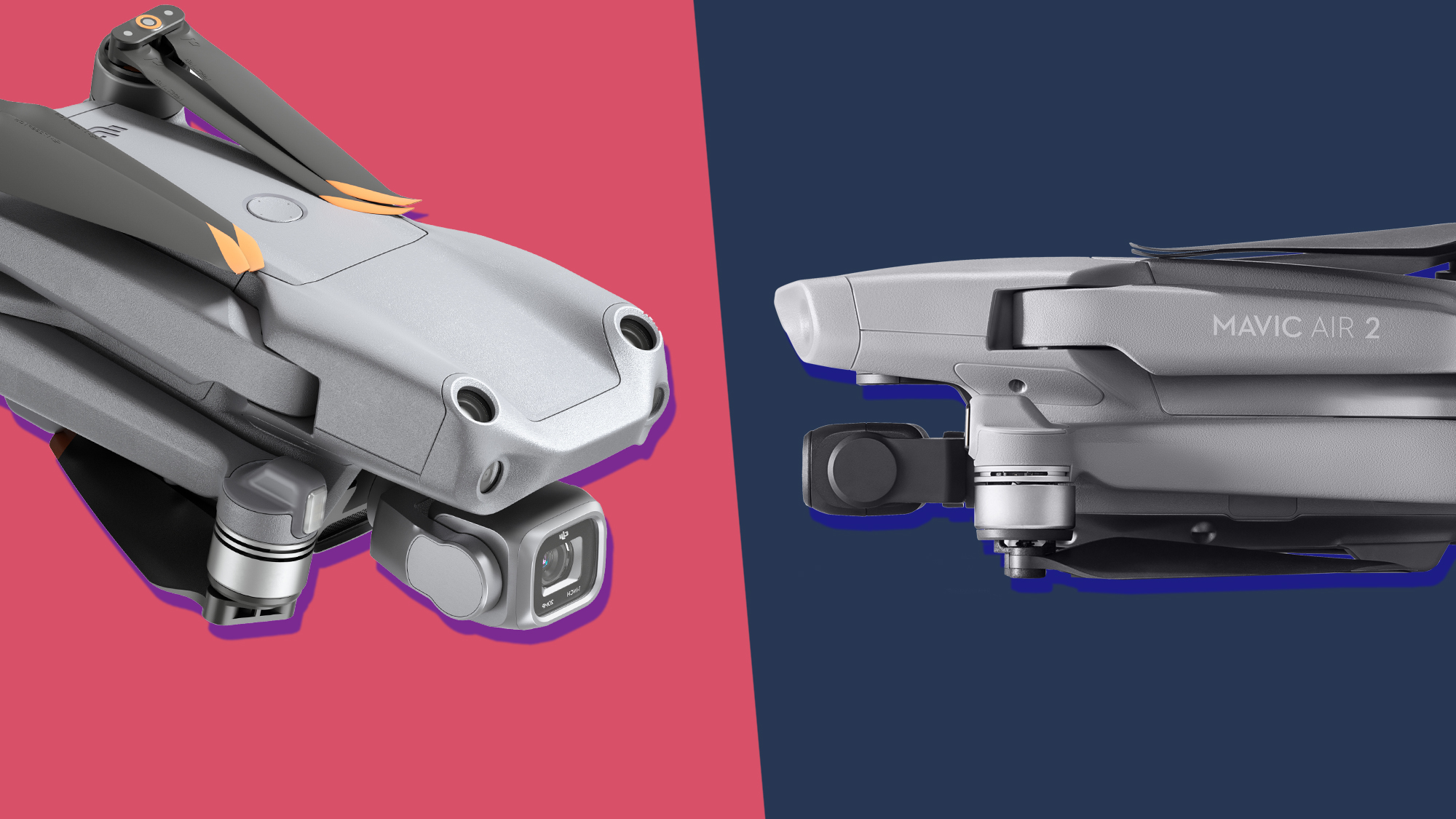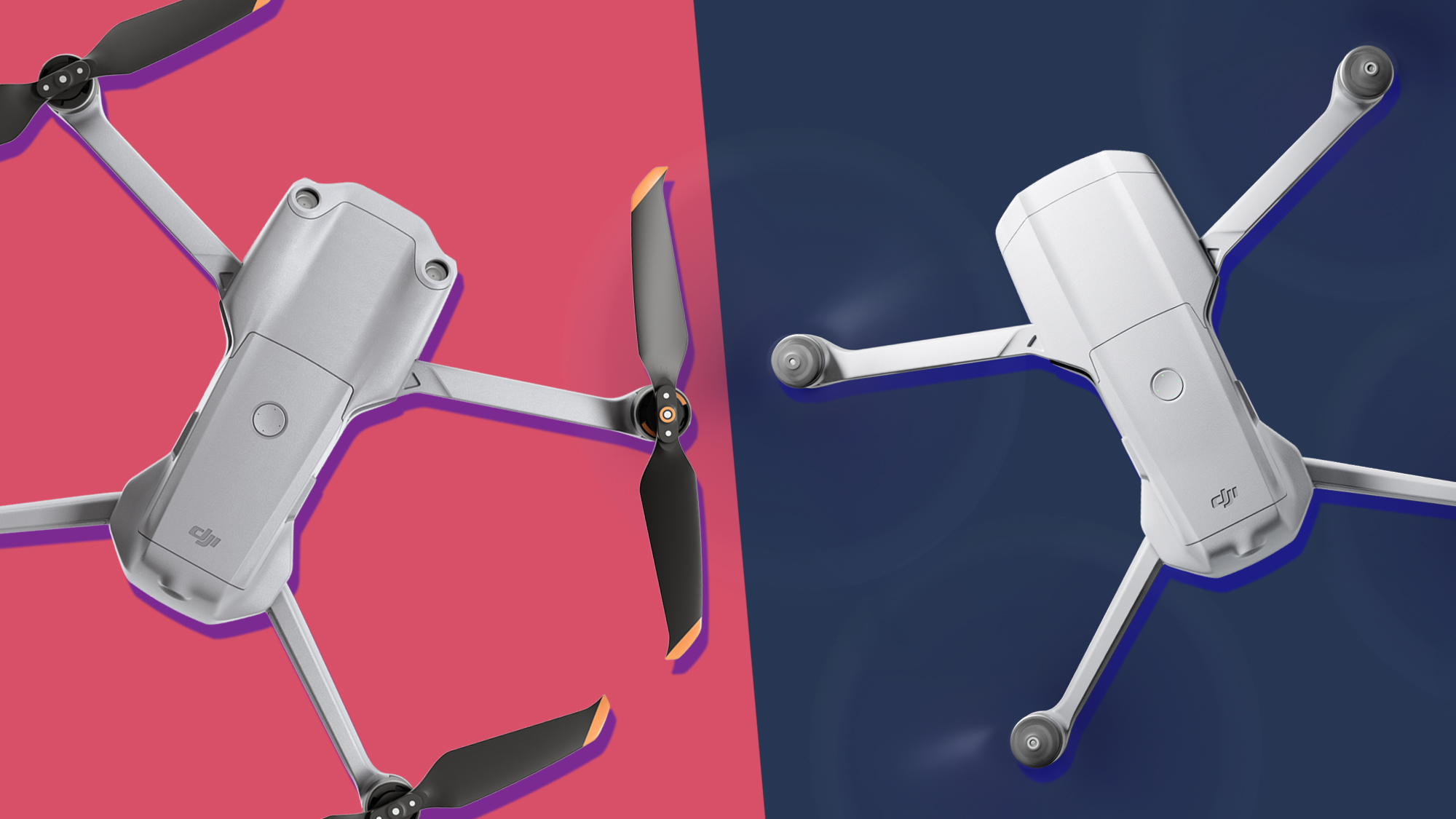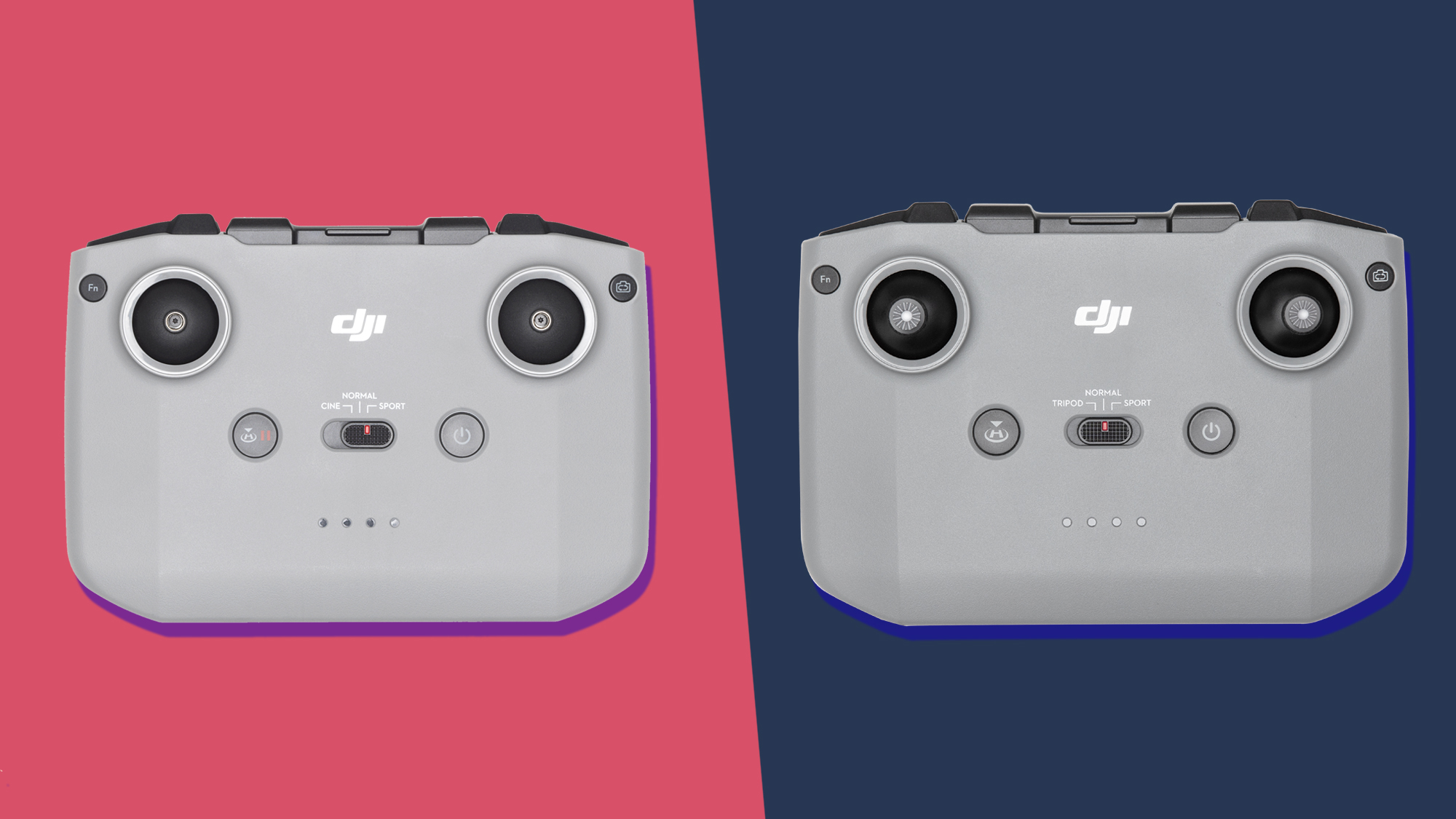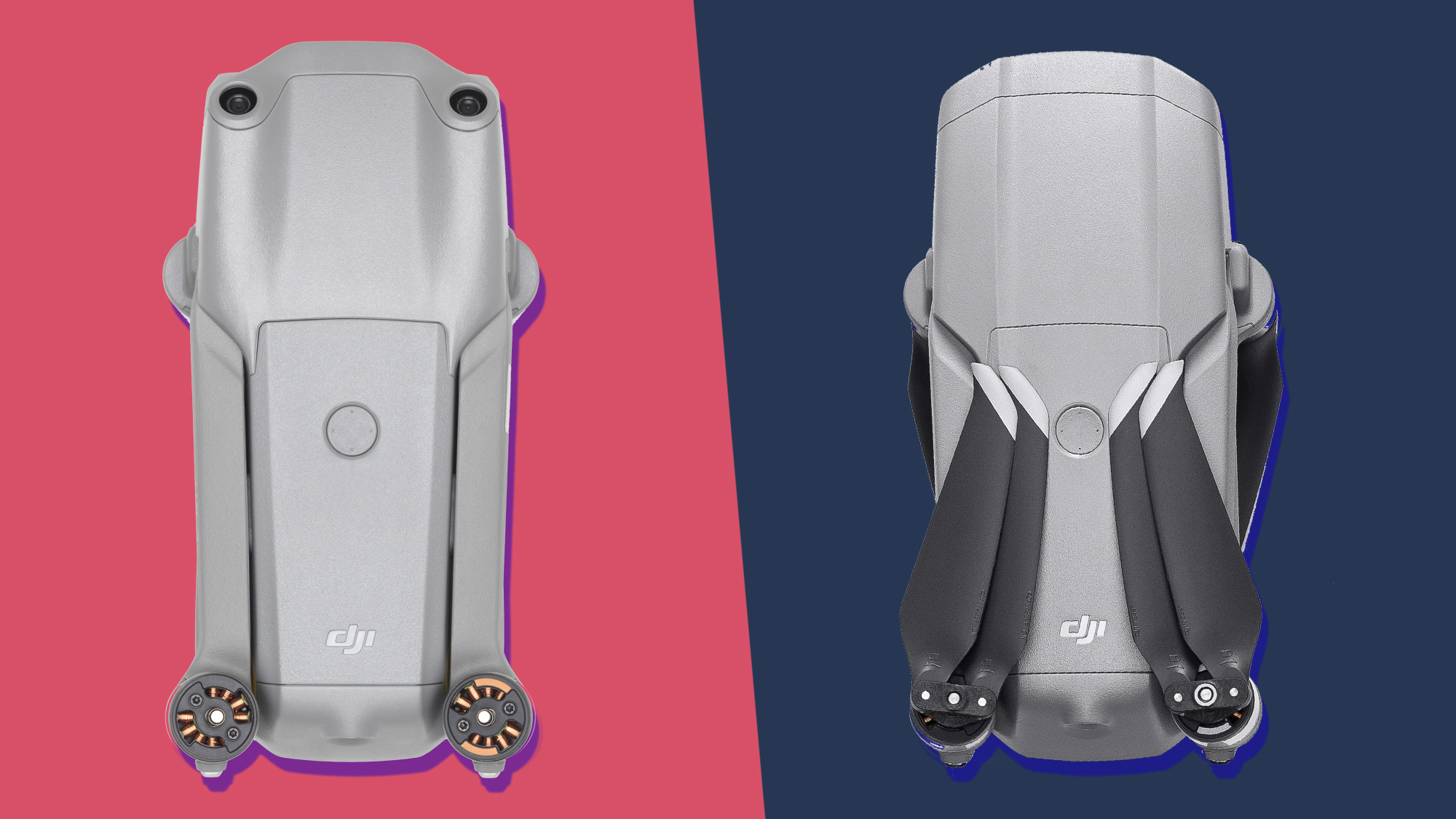DJI Mavic Air 2 vs Air 2S: which drone should you buy?

The DJI Mavic Air 2 and Air 2S are the drone giant's two mid-range flying machines, with similar designs and price tags. So which one should you buy? We've picked apart the seven key differences between them based on our extensive flying time with both models to help you decide.
The DJI Air 2S is the newer model, having landed in April 2021. It's the successor to the Mavic Air 2, which arrived a year earlier. While both drones have a lot in common, the Air 2S brings one big advantage – a new 20MP 1-inch camera with greater video powers – along with a host of smaller ones, including improved connectivity and a new zoom function.
Since these two drones arrived, DJI has also launched the DJI Mini 3 Pro. Weighing in at 249g, this model is smaller than both while packing a sensor size (1/1.3-inch) that sits in between the 1/2-inch Mavic Air 2 and 1-inch Air 2S. It's certainly an option to consider, so to read our in-depth thoughts check out our DJI Mini 3 Pro review.
In our DJI Air 2S review, we were particularly impressed with its image quality, so much so that it's currently top of our guide to the best drones you can buy. On the other hand, the DJI Mavic Air 2 (which has remained on sale) is much cheaper and even edges the Air 2S in some areas, including battery life and weight. Our DJI Mavic Air 2 review found that its 12MP 1/2-inch Quad Bayer sensor still produced impressively clean images at all ISO levels.
So how do you decide which aerial companion is the best for you? To help, we've explained how the two drones compare in seven key areas based on our time with both drones. And then to finish, we've concluded which one we think offers the best value for money and deserves to win the great 'DJI Mavic Air 2 vs Air 2S' debate.
1. DJI Mavic Air 2 vs Air 2S sensor: The Air 2S has a 1-inch sensor
The biggest difference between the DJI Air 2S and the Mavic Air 2 is their sensors. While the Air 2 has a 1/2-inch chip, the Air 2S has a much larger 1-inch sensor. That means the new drone has greater light-gathering powers, which were very apparent in our tests.
While the Mavic Air 2's footage remains impressive for its size, the Air 2S is a real step up for both videos and stills. In fact, it even gives the higher-end Mavic 2 Pro a good run for its money – which isn't surprising, seeing as that drone also has a 1-inch sensor.

The Air 2S' new sensor and image processing pipeline bring a couple of other benefits, too. It can shoot 5.4K/30p or 4K/60p video, both of which are beyond the Mavic Air 2's top resolution and frame-rate of 4K/30p.
Sign up for breaking news, reviews, opinion, top tech deals, and more.
It's worth bearing in mind that there is a slight crop when you shoot in 4K/60p on the Air 2S, but it does also trump its older cousin in terms of maximum video bit-rate (150Mbps, compared to 120Mbps).
Even more importantly for those who like to color-grade their videos, the Air 2S can also shoot in 10-bit D-Log or HLG formats, which trumps its sibling's 8-bit limit.

On the other hand, the Air 2S' stills photo resolution tops out at 20MP, compared to 48MP on the Mavic Air 2. We weren't hugely impressed with the 48MP mode on the latter, though, which produces softer raw files and JPEGs than its 12MP shots, along with washed out and desaturated colors.
Overall, the Mavic Air 2's overall performance is more than good enough for hobbyist shooters, but the Air 2S and its new sensor definitely straddle a higher line between enthusiast and pro levels.
2. DJI Mavic Air 2 vs Air 2S design: The Air 2S has better obstacle avoidance
These two drones have almost identical designs, with folding bodies that have very similar weights (the Air 2S is 25g heavier) and dimensions (the Mavic Air 2 is 4mm longer).
One small difference, though, is that the Air 2S has an extra pair of obstacle avoidance sensors on the top. These join the ones you already got on the Mavic Air 2, which are on the front, rear and bottom of the drone.

In reality, this doesn't make a dramatic difference, unless you rely heavily on the Advanced Pilot Assistance System (APAS), which lets you set the drone to stop or fly autonomously around objects.
Despite their many sensors and clever automated flying, DJI drones are still most comfortable when they have a clear path to fly through – and if this is mostly how you tend to shoot, then this is a relatively minor difference between the Air 2S and Mavic Air 2.
3. DJI Mavic Air 2 vs Air 2S shooting modes: The Air 2S brings MasterShots
Both the Air 2S and Mavic Air 2 are packed with automated flying modes. The main difference between the two is that the Air 2S brings upgraded versions of these modes, including ActiveTrack 4.0 and Advanced Pilot Assistance System (APAS) 4.0, and also adds a new one called MasterShots.
MasterShots is another handy mode aimed at beginner flyers. Once you've chosen a subject for it to focus on, it'll automatically record a video on one of three presets routes, and also edit the footage with soundtracks and subtitles if needed.
In short, it's a bit like DJI's answer to GoPro's QuikStories feature, and we've so far found it to be a similar experience. While it's a good way to quickly get some pro-looking footage, you'll likely want to quickly move onto the more useful QuickShots or manual flight controls.
Given that the Mavic Air 2 already has the same the FocusTrack modes as the Air 2S, though, we'd say these flying features probably aren't a reason to upgrade to the newer model. The much bigger difference between the two drones is their sensors.
4. DJI Mavic Air 2 vs Air 2S range and transmission: The Air 2S is a step up
The Air 2S has the edge over the Mavic Air 2 when it comes to both range and the stability of its connection to the controller, thanks to the inclusion of DJI's Ocusync 3.0 system.
A drone's transmission system can affect a few things, including how far away you can fly it, the resolution of the video feed sent to your smartphone, the speed at which you can download videos from the drone, and the overall stability of the signal.

The Mavic Air 2 uses Ocusync 2.0 and we certainly had no major complaints about that system, aside from the video feed occasionally stuttering and locking while flying.
But Ocusync 3.0 is certainly a step up, boosting its maximum range from 10km to 12km (or from 6km to 8km outside the US) and slightly improving the reliability of the connection, particularly when you're flying it overhead.
Again, it isn't a revolutionary leap over the Mavic Air 2, but is another bonus of going for the newer model. The inclusion of Ocusync 3.0 on the Air 2S does also bring the (distant) possibility of the drone being compatible with the DJI Goggles V2.0 for a First Person View (FPV) flying experience.
Sadly, while DJI said this is "theoretically" possible, it added that "there's no roadmap or timeline for this", so it can't be counted as another reason to go for the Air 2S. It also looks increasingly unlikely, given that DJI's FAQ for the drone still says "there is currently no plan to add support" for the Goggles to the Air 2S.
5. DJI Mavic Air 2 vs Air 2S battery life: The Mavic Air 2 has the slight edge
Considering the DJI Air 2S has a new camera, more sensors and a slightly heavier body than the Mavic Air 2, you might expect its battery life to be considerably worse, given both drones use the same type of battery.
But in real-world use, there isn't actually much difference between them. The quoted flight times for the drones is 31 minutes for the Air 2S and 34 minutes for the Mavic Air 2. In our tests, we found that the Air 2S actually gives you (like the Mavic Air 2) around 20 minutes of actual flight time, which is about par for drones of this size.

The reason for that missing ten minutes from the official figures is because DJI's quoted time is for when there's no wind. Its drones' automatic Return-to-Home function also kicks in when you have 25% of your battery left.
This is why we always recommend going for DJI's 'Fly More' bundles if you can afford to, because they include two spare batteries to give you a bit more leeway.
6. DJI Mavic Air 2 vs Air 2S zoom: A useful bonus feature on the Air 2S
While neither of these drones have optical zoom seen on the DJI Mavic 2 Zoom, the Air 2S does draw on its 5.4K resolution to provide a pretty useful digital zoom function. This isn't available at all on the Mavic Air 2.
Normally, we wouldn't recommend using digital zoom, because it tends to reduce image quality by cropping into your image. But because the Air 2S' new camera can shoot at 5.4K resolution, there is some additional leeway that allows it to offer a sliding scale of zoom at different resolutions.
On paper, this goes up to 8x zoom when you're shooting 1080/30p video or 4x zoom during its 4K/30p mode. In reality, we wouldn't recommend going beyond 2x zoom, but even that is a useful feature that allows you to get closer to subjects when conditions (or your local drone laws) won't allow it.
The wide-angle lenses on most drones can be a double-edged sword, with the ability to get whole scenes in your shot counter-balanced by the difficulty of singling out specific subjects. We think the Air 2S' zoom function is a useful advantage over the Mavic Air 2 and could be worth bearing in mind, depending on the kind of shooting you're planning to do.
A word of warning, though: the zoom function isn't available when you're shooting 10-bit videos, 120fps slo-mo or still photos, so it's also not quite as versatile as we'd hoped.
7. DJI Mavic Air 2 vs Air 2S price: The Air 2S justifies its premium
Perhaps the biggest factor for most people when buying a drone is the cost – so how do these two mid-range models compare?
Somewhat disappointingly, the DJI Mavic Air 2 has remained at its launch price, despite the arrival of its newer sibling. Still, it isn't exactly an old model – and we still think it offers good value considering its performance.
But given the Air 2S' new 1-inch sensor, 10-bit video recording, new zoom function and Ocusync 3.0 connectivity, we think it currently justifies its premium over the Mavic Air 2.
| Row 0 - Cell 0 | Standard bundle | Fly More bundle |
| DJI Air 2S | £899 / $999 / AU $1,699 | $1,299 / £1,169 AU $2,099 |
| DJI Mavic Air 2 | $799 / £769 / AU$1,499 | $999 / £949 / AU$1,899 |
The slightly tempting aspect of the DJI Mavic Air 2's price, for US and UK buyers in particular, is that its 'Fly More' bundle dips under the $1,000 / £1,000 mark. Given we usually recommend buying that bundle (which brings features like two extra batteries, a carry case and more), we could see why that may well tempt some buyers.
An equivalent bundle for the Air 2S, meanwhile, pushes it into the pricing territory of the DJI Mavic 2 Pro. But again, we don't see this as an issue for the Air 2S – in fact, you can read about why our reviewer is actually planning to sell his Mavic 2 Pro for the Air 2S.
In short, the DJI Air 2S' size, camera and features make it the best all-round drone we've tested – and while a price reduction for the Mavic Air 2 during shopping events like Prime Day and Black Friday could well make it a real bargain, right now DJI's newer model is the one most buyers should plump for.

Mark is TechRadar's Senior news editor. Having worked in tech journalism for a ludicrous 17 years, Mark is now attempting to break the world record for the number of camera bags hoarded by one person. He was previously Cameras Editor at both TechRadar and Trusted Reviews, Acting editor on Stuff.tv, as well as Features editor and Reviews editor on Stuff magazine. As a freelancer, he's contributed to titles including The Sunday Times, FourFourTwo and Arena. And in a former life, he also won The Daily Telegraph's Young Sportswriter of the Year. But that was before he discovered the strange joys of getting up at 4am for a photo shoot in London's Square Mile.